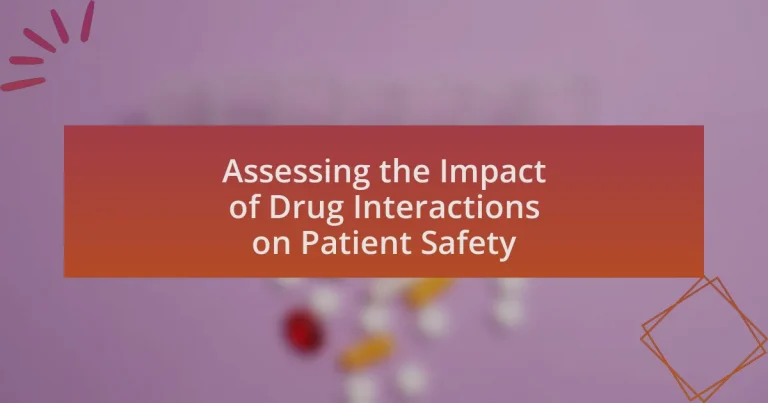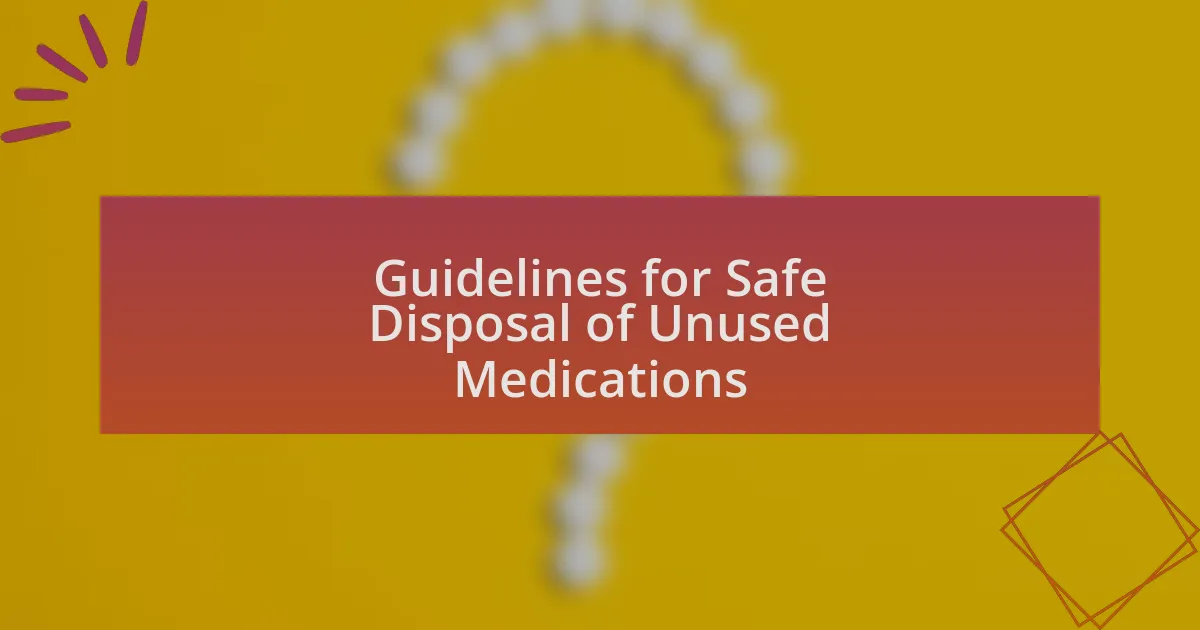Drug interactions refer to the alterations in the effects of one drug caused by the presence of another drug, food, or substance, which can lead to reduced efficacy or increased toxicity. This article examines the significance of drug interactions for patient safety, detailing how they occur, the different types, and the factors that contribute to their likelihood. It also explores the potential consequences of drug interactions, methods for assessing their impact, and strategies to enhance patient safety, including the role of healthcare providers and technology in managing these interactions. Key takeaways for both healthcare professionals and patients are highlighted to promote effective medication management and minimize risks associated with drug interactions.
What are Drug Interactions and Why are They Important for Patient Safety?
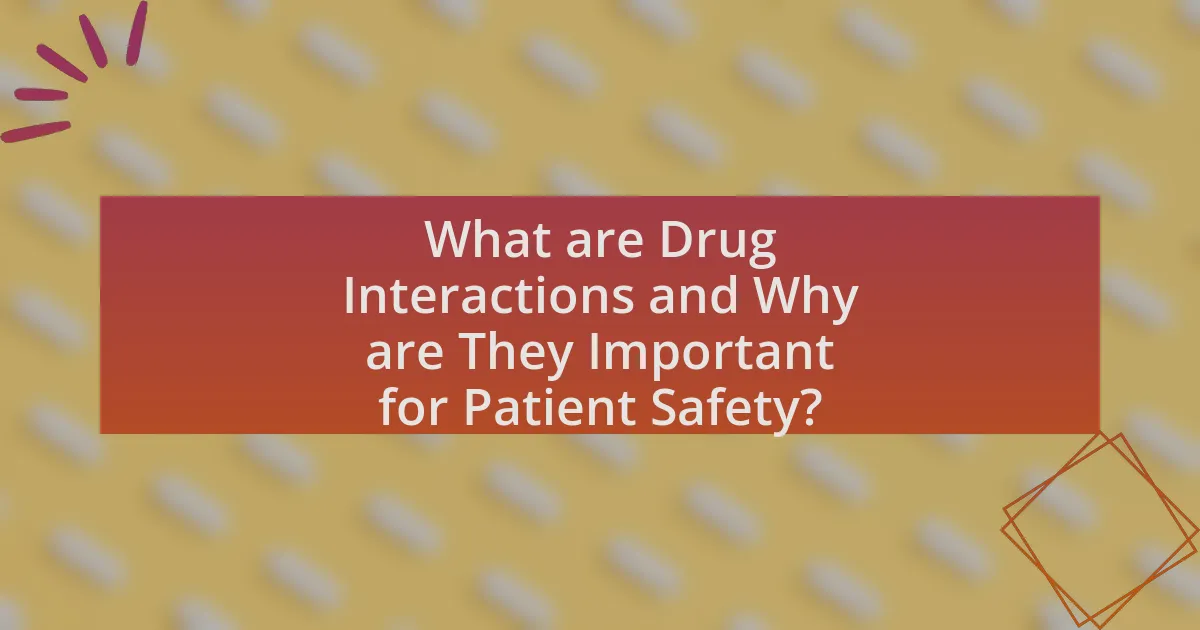
Drug interactions occur when the effects of one drug are altered by the presence of another drug, food, or substance, potentially leading to reduced efficacy or increased toxicity. These interactions are crucial for patient safety because they can result in adverse effects, therapeutic failures, or even life-threatening situations. For instance, the combination of certain antibiotics with anticoagulants can enhance bleeding risk, highlighting the need for careful medication management. Understanding drug interactions helps healthcare providers make informed decisions, ensuring that patients receive safe and effective treatment regimens.
How do drug interactions occur?
Drug interactions occur when one drug affects the pharmacological action of another drug, leading to altered effects. This can happen through various mechanisms, including changes in drug absorption, metabolism, or excretion. For example, certain medications can inhibit or induce liver enzymes responsible for drug metabolism, resulting in increased toxicity or reduced efficacy of the affected drug. According to the National Institute of Health, approximately 20% of adverse drug reactions are due to drug interactions, highlighting their significance in patient safety.
What are the different types of drug interactions?
There are three main types of drug interactions: pharmacodynamic interactions, pharmacokinetic interactions, and drug-drug interactions. Pharmacodynamic interactions occur when two drugs have additive, synergistic, or antagonistic effects on the same physiological pathway. Pharmacokinetic interactions involve changes in the absorption, distribution, metabolism, or excretion of a drug due to the presence of another drug, which can alter drug levels in the body. Drug-drug interactions specifically refer to the effects that one drug has on another when both are administered together, potentially leading to increased toxicity or reduced therapeutic efficacy. These classifications are critical for understanding how drug interactions can impact patient safety and treatment outcomes.
What factors contribute to the likelihood of drug interactions?
The likelihood of drug interactions is influenced by several factors, including polypharmacy, pharmacokinetic properties, and patient-specific characteristics. Polypharmacy, defined as the concurrent use of multiple medications, significantly increases the risk of interactions due to the complexity of managing various drug effects. Pharmacokinetic properties, such as absorption, distribution, metabolism, and excretion, play a crucial role; for instance, drugs that inhibit or induce cytochrome P450 enzymes can alter the metabolism of co-administered medications, leading to increased toxicity or reduced efficacy. Additionally, patient-specific characteristics, including age, genetic factors, and existing health conditions, can affect how drugs interact within an individual’s body, further contributing to the likelihood of adverse drug interactions.
What are the potential consequences of drug interactions?
Drug interactions can lead to serious health consequences, including increased toxicity, reduced therapeutic efficacy, and unexpected side effects. For instance, when two drugs that are metabolized by the same liver enzyme are taken together, one drug may inhibit the metabolism of the other, leading to elevated levels of the second drug in the bloodstream, which can cause toxicity. According to a study published in the Journal of the American Medical Association, approximately 20% of hospital admissions are related to adverse drug reactions, many of which are due to drug interactions. This highlights the critical need for healthcare providers to assess potential drug interactions to ensure patient safety.
How can drug interactions affect patient outcomes?
Drug interactions can significantly affect patient outcomes by altering the efficacy and safety of medications. These interactions may lead to increased toxicity, reduced therapeutic effects, or unexpected side effects, which can complicate treatment regimens. For instance, a study published in the Journal of the American Medical Association found that approximately 20% of hospitalized patients experience adverse drug events due to drug interactions, highlighting the critical need for careful medication management.
What role do adverse drug reactions play in patient safety?
Adverse drug reactions (ADRs) significantly impact patient safety by leading to preventable harm, increased healthcare costs, and extended hospital stays. Studies indicate that ADRs account for approximately 5-10% of hospital admissions, highlighting their critical role in compromising patient safety. Furthermore, the World Health Organization reports that ADRs contribute to about 1 in 16 hospitalizations, underscoring the necessity for vigilant monitoring and management of medications to enhance patient safety.
How is the Impact of Drug Interactions Assessed?
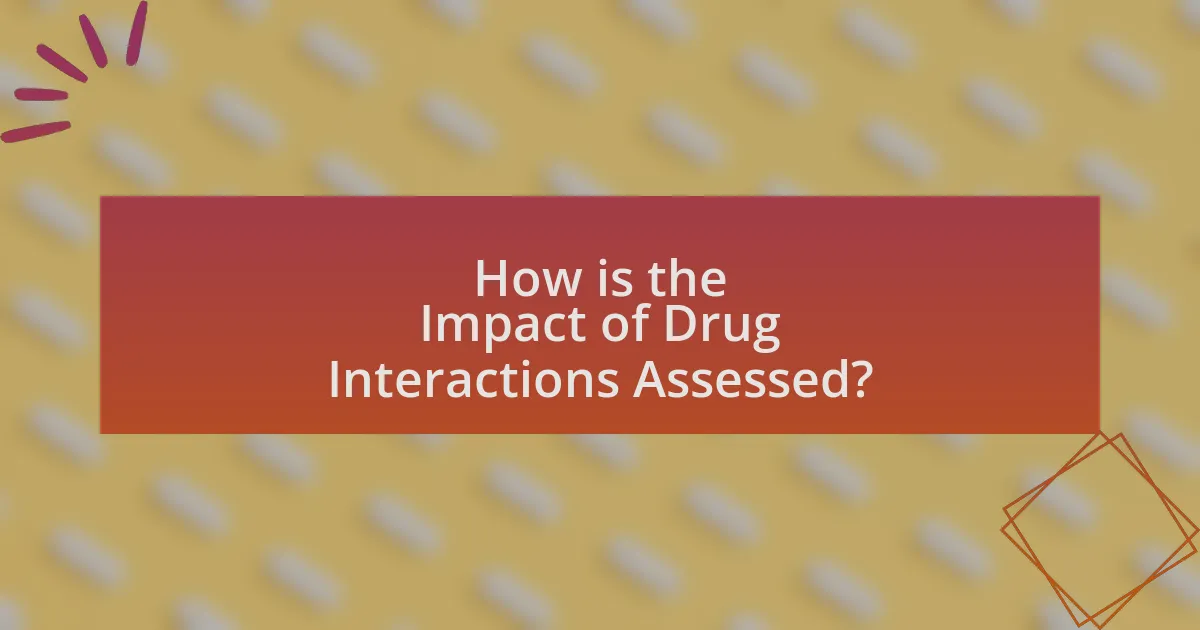
The impact of drug interactions is assessed through various methodologies, including clinical studies, pharmacokinetic modeling, and adverse event reporting systems. Clinical studies provide empirical data on how drugs interact in real-world settings, while pharmacokinetic modeling predicts the absorption, distribution, metabolism, and excretion of drugs when combined. Adverse event reporting systems collect data on negative outcomes associated with drug interactions, allowing for the identification of patterns and risks. These methods collectively contribute to understanding the safety implications of drug interactions, ensuring that healthcare providers can make informed decisions regarding patient treatment plans.
What methods are used to evaluate drug interactions?
Methods used to evaluate drug interactions include in vitro studies, in vivo studies, and computational modeling. In vitro studies assess drug interactions using cell cultures or biochemical assays to observe effects on drug metabolism and transport. In vivo studies involve clinical trials or observational studies in humans or animal models to evaluate the pharmacokinetic and pharmacodynamic interactions in a real biological context. Computational modeling employs algorithms and simulations to predict potential interactions based on chemical structure and biological pathways. These methods collectively provide a comprehensive understanding of how drugs may interact, ensuring patient safety by identifying potential adverse effects before clinical use.
How do clinical studies contribute to understanding drug interactions?
Clinical studies contribute to understanding drug interactions by systematically evaluating how different medications affect each other’s pharmacokinetics and pharmacodynamics in human subjects. These studies provide empirical data on the effects of co-administered drugs, revealing potential adverse reactions, altered efficacy, or unexpected side effects. For instance, a clinical trial may demonstrate that the concurrent use of a specific antibiotic and anticoagulant leads to increased bleeding risk, thereby informing healthcare providers about necessary dosage adjustments or monitoring strategies. Such findings are crucial for developing clinical guidelines and ensuring patient safety, as evidenced by the FDA’s requirement for drug interaction studies during the approval process, which helps mitigate risks associated with polypharmacy.
What tools and databases are available for assessing drug interactions?
Several tools and databases are available for assessing drug interactions, including Micromedex, Lexicomp, and Drug Interaction Checker by the National Library of Medicine. Micromedex provides comprehensive drug information and interaction analysis, while Lexicomp offers a user-friendly interface for healthcare professionals to evaluate potential interactions. The National Library of Medicine’s Drug Interaction Checker allows users to input multiple medications to identify possible interactions. These resources are widely used in clinical settings to enhance patient safety by preventing adverse drug interactions.
What are the challenges in assessing drug interactions?
Assessing drug interactions presents several challenges, primarily due to the complexity of pharmacokinetics and pharmacodynamics involved. The variability in individual patient responses, influenced by factors such as genetics, age, and comorbidities, complicates the prediction of interactions. Additionally, the vast number of potential drug combinations and the limited availability of comprehensive databases make it difficult to identify all possible interactions. Research indicates that adverse drug reactions, often stemming from interactions, account for a significant percentage of hospital admissions, highlighting the critical need for accurate assessment methods.
How does patient variability affect assessment outcomes?
Patient variability significantly affects assessment outcomes by influencing how individuals respond to medications and treatments. Factors such as genetics, age, sex, comorbidities, and lifestyle can lead to differences in drug metabolism, efficacy, and safety profiles. For instance, pharmacogenomic studies have shown that genetic variations can alter enzyme activity responsible for drug metabolism, resulting in varied therapeutic responses among patients. This variability can lead to under-treatment or adverse drug reactions, ultimately impacting patient safety and treatment effectiveness.
What limitations exist in current assessment methodologies?
Current assessment methodologies for evaluating drug interactions often lack comprehensive data integration, which limits their effectiveness. Many existing methods rely on isolated studies or databases that do not account for the full spectrum of patient variability, including genetic factors, comorbidities, and concurrent medications. This fragmentation can lead to incomplete risk assessments and potentially unsafe clinical decisions. Additionally, many methodologies do not incorporate real-world evidence, which is crucial for understanding the complexities of drug interactions in diverse patient populations.
What Strategies Can Enhance Patient Safety Regarding Drug Interactions?
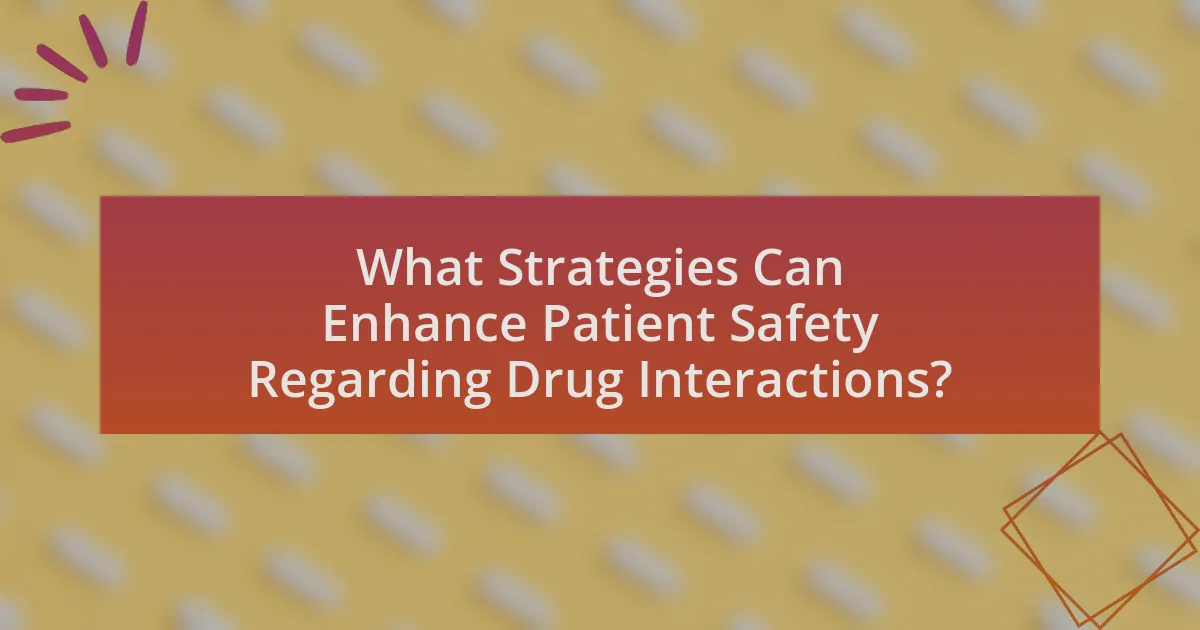
Implementing comprehensive medication management strategies can significantly enhance patient safety regarding drug interactions. These strategies include conducting thorough medication reconciliation at every healthcare encounter, utilizing clinical decision support systems to alert healthcare providers of potential interactions, and educating patients about their medications and possible side effects. Research indicates that medication reconciliation can reduce adverse drug events by up to 50%, while clinical decision support systems have been shown to improve prescribing accuracy and reduce harmful interactions. Additionally, patient education fosters adherence and empowers individuals to report any unusual symptoms, further mitigating risks associated with drug interactions.
How can healthcare providers minimize the risk of drug interactions?
Healthcare providers can minimize the risk of drug interactions by conducting thorough medication reviews and utilizing clinical decision support systems. These practices enable providers to identify potential interactions before prescribing medications. Research indicates that implementing electronic health records with integrated drug interaction alerts can reduce adverse drug events by up to 50%. Additionally, educating patients about their medications and encouraging them to report all drugs they are taking, including over-the-counter and herbal supplements, further enhances safety.
What role does patient education play in preventing drug interactions?
Patient education plays a crucial role in preventing drug interactions by empowering patients with knowledge about their medications. Educated patients are more likely to understand the importance of adhering to prescribed regimens, recognizing potential side effects, and identifying harmful interactions between different drugs. Studies have shown that when patients receive comprehensive education regarding their medications, including how to take them and what to avoid, the incidence of adverse drug interactions decreases significantly. For instance, a study published in the Journal of Patient Safety found that targeted educational interventions reduced medication errors by 30%, highlighting the effectiveness of patient education in enhancing medication safety.
How can technology assist in managing drug interactions?
Technology can assist in managing drug interactions through the use of electronic health records (EHRs) and clinical decision support systems (CDSS). EHRs enable healthcare providers to access comprehensive patient medication histories, which helps identify potential drug interactions. CDSS can analyze patient data in real-time, alerting clinicians to possible adverse interactions based on established databases and algorithms. For instance, a study published in the Journal of the American Medical Informatics Association found that implementing CDSS significantly reduced the incidence of drug interaction-related adverse events, demonstrating the effectiveness of technology in enhancing patient safety.
What best practices should be followed for monitoring drug interactions?
Best practices for monitoring drug interactions include conducting thorough medication reviews, utilizing drug interaction databases, and implementing regular patient assessments. Medication reviews involve evaluating all prescribed and over-the-counter medications to identify potential interactions. Drug interaction databases, such as Micromedex or Lexicomp, provide evidence-based information on known interactions, helping healthcare providers make informed decisions. Regular patient assessments, including monitoring for adverse effects and therapeutic outcomes, ensure timely identification of any issues arising from drug interactions. These practices are supported by studies indicating that systematic monitoring can significantly reduce the risk of adverse drug events, thereby enhancing patient safety.
How can regular medication reviews improve patient safety?
Regular medication reviews can significantly improve patient safety by identifying and mitigating potential drug interactions and adverse effects. These reviews allow healthcare providers to evaluate the appropriateness of prescribed medications, ensuring that they align with the patient’s current health status and treatment goals. For instance, a study published in the Journal of the American Medical Association found that systematic medication reviews reduced adverse drug events by 30%, highlighting their effectiveness in enhancing patient safety. By regularly assessing medications, healthcare professionals can adjust dosages, discontinue unnecessary drugs, and educate patients about their medications, ultimately leading to safer therapeutic outcomes.
What are the key takeaways for healthcare professionals in managing drug interactions?
Healthcare professionals must prioritize thorough medication reviews to effectively manage drug interactions. This involves assessing all medications a patient is taking, including over-the-counter drugs and supplements, to identify potential interactions. Evidence shows that approximately 20% of hospital admissions are due to adverse drug reactions, many of which stem from drug interactions. Additionally, healthcare professionals should utilize clinical decision support tools and databases to stay informed about known interactions and their clinical significance. Regular communication with patients about their medication regimens and any changes in their health status is crucial for preventing harmful interactions.
What practical tips can patients follow to avoid drug interactions?
Patients can avoid drug interactions by maintaining an updated list of all medications, including over-the-counter drugs and supplements, and sharing this list with healthcare providers. This practice ensures that doctors and pharmacists can identify potential interactions before prescribing new medications. Additionally, patients should consult their healthcare providers or pharmacists before starting any new medication, as they can provide guidance on possible interactions. Regularly reviewing medications with a healthcare professional can also help in managing and adjusting dosages as needed to minimize risks.
